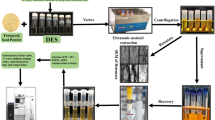Abstract
Reversed-phase LC on C-18 bonded silica with a methanol–ammonium formate gradient was used to determine the main flavonoids in leaves of four species of the Leguminosae family. The detection modes were diode-array UV absorbance, fluorescence, and (tandem) mass spectrometry. LC–UV was used for a general screening, sub-classification, and the calculation of total flavonoid contents. LC–FLU was included to identify isoflavones on the basis of their native fluorescence. Most structural information regarding aglycons, sugar moieties, and acidic groups was derived from LC–MS in both the full-scan and extracted-ion mode, using negative-ion atmospheric pressure chemical ionization. MS/MS did not provide much additional information, because the same fragments were observed as in full-scan MS.
In T. pratense and T. repens, the main constituents were flavonoid glucoside–(di)malonates, while T. dubium and L. corniculatus mainly contained flavonoid (di)glycosides. Satellite sets comprising an aglycon, the glucoside and glucoside–malonates or –acetates, were abundantly present only in T. pratense. Generally speaking, the main aglycons and sugars in the four plant species are surprisingly different. In addition, while the results for T. pratense are similar to those reported in the literature, there is little agreement in the case of the other species. Finally, total flavonoid contents ranged from 50–65 mg/g for L. corniculatus and T. dubium, to 15 mg/g for T. pratense and only 1 mg/g for T. repens.











Similar content being viewed by others
References
Biggs DR, Lane GA (1978) Phytochemistry 17:1683
Hahlbrock K, Scheel D (1989) Ann Rev Plant Physiol Plant Mol Biol 40:347
Stafford HA (1990) Flavonoid metabolism. CRC, Boca Raton, FL, USA
Li J, Ou-Li TM, Raba R, Amundson RG, Last RL (1993) Plant Cell:171
Goto T, Kondo T (1991) Angew Chem 103:17
Rice-Evans CA, Miller NJ, Paganga G (1997) Trends Plant Sci 2:152
Miksicek PJ (1993) Mol Pharmacol 44:37
Wollenweber E (1988) In: Cody V, Middleton E Jr, Harborne JB, Beretz A (eds) Plant flavonoids in biology and medicine II: biochemical, cellular and medicinal properties. Liss, New York, pp 45–55
Weidenborner M, Jha HC (1994) Mycolog Res 98: 1376
de Rijke E, Zappey H, Ariese F, Gooijer C, Brinkman UATh (2003) J Chromatogr A 984:45
de Rijke E, Zafra-Gómez A, Ariese F, Brinkman UATh, Gooijer C (2001) J Chromatogr A 932:55
Lin LZ, He XG, Lindenmaier M, Yang J, Cleary M, Qiu SX, Cordell GA (2000) J Agric Food Chem 48:354
Klejdus B, Vitamvásová D, Kubán V (1999) J Chromatogr A 839:261
He XG (2000) J Chromatogr A 880:203
Justesen U (2222) J Chromatogr A 902:369
Andlauer W, Martena MJ, Fürst P (1999) J Chromatogr A 849:341
Krenn L, Unterrieder I, Ruprechter R (2002) J Chromatogr B 777:123
Aerts RJ, Barry TN, McNabb WC (1999) Agric Ecosyst Environ 75:1
Ingham JL (1978) Biochem Syst Ecol 6:217
Hofmann RW, Swinny EE, Bloor SJ, Markham KR, Ryan KG, Campbell BD, Jordan BR, Fountain DW (2000) Ann Botan 86:527
Mathesius U (2001) J Exptl Bot 52:419
Vetter J (1995) J Agric Food Chem 43:106
Fossen T, Andersen OM (1995) Phytochemistry 40:1809
de Rijke E, Joshi HC, Sanderse HR, Ariese F, Brinkman UATh, Gooijer C (2002) Anal Chim Acta 468:3
Mabry TJ, Harborne JB, Thomas MB (eds) (1970) The systematic identification of flavonoids. Springer, Berlin Heidelberg New York
Ma YL, Vedernikova I, van den Heuvel H, Claeys M (2000) J Am Soc Mass Spectrom 11:136
Schittko U, Burghardt F, Fiedler K,Wray V , Proksch P (1999) Phytochemistry 51:609
Reynaud J, Jay M, Raynaud J (1982) Phytochemistry 21:2604
Jay M, Hasan A, Voirin B, Viricel MR (1978) Phytochemistry 17:827
Harborne JB (1965) Phytochemistry 4:647
Middelton E Jr, Kandaswami C, Harborne JB (eds) (1994) The flavonoids: advances in research since 1986. Chapman and Hall, Cambridge, UK
Domon B, Costello C (1988) Glycocon J 5:397
Author information
Authors and Affiliations
Corresponding author
Rights and permissions
About this article
Cite this article
de Rijke, E., Zappey, H., Ariese, F. et al. Flavonoids in Leguminosae: Analysis of extracts of T. pratense L., T. dubium L., T. repens L., and L. corniculatus L. leaves using liquid chromatography with UV, mass spectrometric and fluorescence detection. Anal Bioanal Chem 378, 995–1006 (2004). https://doi.org/10.1007/s00216-003-2310-6
Received:
Revised:
Accepted:
Published:
Issue Date:
DOI: https://doi.org/10.1007/s00216-003-2310-6




